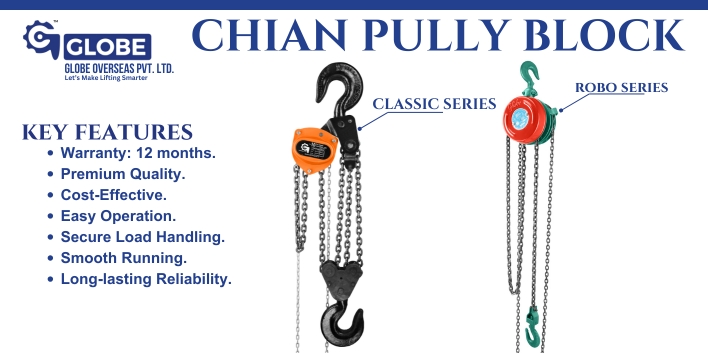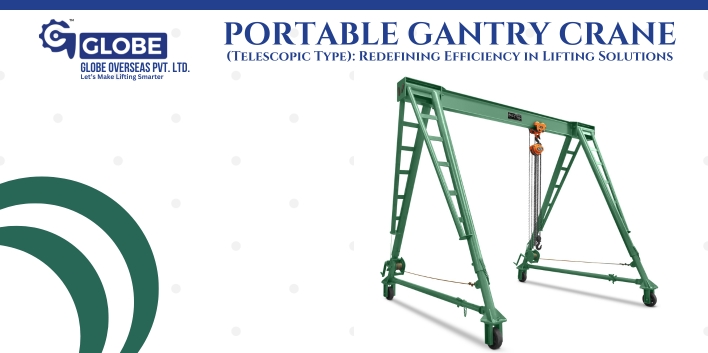Cricket is more than just a sport in India; it is…

What is a Chain Pully Block?
Lifting Made Easy: Chain Pully Blocks
In the world of material handling, efficiency and safety are paramount. When it comes to lifting and moving heavy loads, chain pulley blocks have proven to be reliable and versatile tools. These simple yet ingenious devices leverage the principle of mechanical advantage to make lifting tasks easier and more manageable.
What is a Chain Pully Block?
A chain pulley block, also known as a chain hoist or chain block, is a mechanical device that uses a system of pulleys and a chain to lift and lower heavy objects. It consists of two main components.
- The Upper Block: This stationary block is attached to a fixed point, such as a ceiling or beam. It contains one or more pulleys that guide the chain.
- The Lower Block: This movable block is connected to the load. It also contains one or more pulleys.
When the chain is pulled, the lower block and the attached load are lifted. The number of pulleys in the system determines the mechanical advantage, which is the ratio of the load lifted to the effort applied.
Types of Chain Pully Blocks
Chain pulley blocks come in various types and capacities to suit different lifting needs. Some common types include:
- Classic Series: These are traditional chain pulley blocks with a simple design and reliable performance. They are suitable for a wide range of lifting applications.
- Robo Series: These are modern chain pulley blocks that incorporate advanced features such as ergonomic handles, smooth running mechanisms, and improved safety features.
Key Features of Chain Pully Blocks
- Warranty: Most chain pulley blocks come with a warranty, typically 12 months, which provides peace of mind to users.
- Premium Quality: Reputable manufacturers use high-quality materials and components to ensure durability and longevity.
- Cost-Effective: Chain pulley blocks are a cost-effective solution for lifting and moving heavy loads compared to other lifting equipment.
- Easy Operation: They are simple to operate, requiring minimal training or expertise.
- Secure Load Handling: The design ensures secure load handling, minimizing the risk of accidents.
- Smooth Running: The use of high-quality bearings and chains ensures smooth and efficient operation.
- Long-lasting Reliability: With proper maintenance, chain pulley blocks can provide years of reliable service.
Applications of Chain Pully Blocks
Chain pulley blocks find applications in various industries and settings, including:
- Construction: Lifting and moving building materials, such as beams, pipes, and panels.
- Manufacturing: Handling heavy machinery, components, and raw materials.
- Warehousing: Loading and unloading goods, moving heavy equipment, and stock management.
- Shipping and Logistics: Loading and unloading cargo from ships and trucks.
- Maintenance and Repair: Accessing and repairing equipment in hard-to-reach areas.
Safety Considerations
When using chain pulley blocks, it is essential to prioritize safety:
- Load Capacity: Always ensure that the chain pulley block is rated for the weight of the load being lifted.
- Regular Inspection: Conduct regular inspections to check for any signs of wear and tear, such as frayed chains or damaged pulleys.
- Proper Training: Ensure that operators are properly trained in the safe use and operation of chain pulley blocks.
- Protective Gear: Wear appropriate safety gear, such as gloves and safety glasses, when operating chain pulley blocks.
- Regular Maintenance: Follow the manufacturer’s recommendations for regular maintenance and lubrication.
Conclusion
Chain pulley blocks are indispensable tools for lifting and moving heavy loads efficiently and safely. Their versatility, reliability, and ease of use make them a popular choice in various industries. By understanding their features, applications, and safety considerations, you can make informed decisions when selecting and using chain pulley blocks.
Remember: Always prioritize safety when working with any lifting equipment. If you have any doubts or concerns, consult with a qualified professional.




